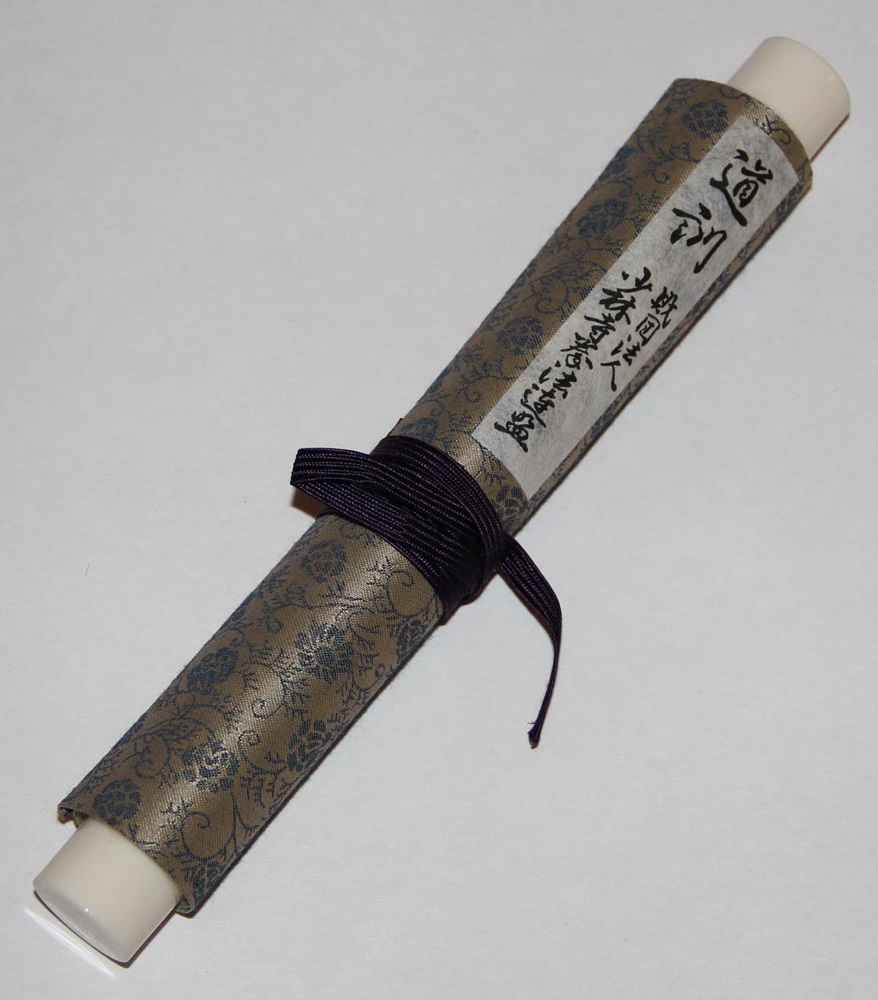Since the Jūni no Kata all follow the
same basic pattern, the table below can be used to
determine the stances and blocking and striking
techniques to fill in the blanks in the above
description. In movements #1, 3, 5, 9, 11, 13, 17,
and 19 simply match the blocking stance with its
corresponding blocking technique (e.g., migi or
hidari ashi-mae heikō dachi with migi
or hidari yoko uke in Jūni
no Kata Sono Ichi), and in movements #2, 4, 6, 7,
8, 10, 12, 14, 15, 16, 18, and 20 match the striking
technique with its corresponding striking technique
(e.g., migi or
hidari ashi-mae heikō dachi with migi
or hidari oizuki chudan in Jūni
no Kata Sono Ichi).
|
Katachi NUMBER |
Blocking Stance |
Blocking Technique |
Striking Stance |
Striking Technique(s) |
|
Sono Ichi |
Ashi-mae Heikō Dachi |
Yoko Uke |
Ashi-mae Heikō Dachi |
Oizuki Chūdan |
|
Sono Ni |
Ashi-mae Heikō Dachi |
Yoko Uke |
Ashi-mae Heikō Dachi |
Choku Geri plus Oizuki Chūdan |
|
Sono San |
Ashi-mae Heikō Dachi |
Gedan Barai |
Ashi-mae Heikō Dachi |
Oizuki Chūdan |
|
Sono Yon |
Ashi-mae Heikō Dachi |
Age Uke |
Ashi-mae Heikō Dachi |
Oizuki Chūdan |
|
Sono Go |
Neko-ashi Dachi |
Yoko Uke |
Ashi-mae Heikō Dachi |
Oizuki Chūdan |
|
Sono Roku |
Neko-ashi Dachi |
Yoko Uke |
Ashi-mae Heikō Dachi |
Choku Geri plus Oizuki Chūdan |
|
Sono Nana |
Neko-ashi Dachi |
Gedan Barai |
Ashi-mae Heikō Dachi |
Oizuki Chūdan |
|
Sono Hachi |
Neko-ashi Dachi |
Age Uke |
Ashi-mae Heikō Dachi |
Oizuki Chūdan |
|
Sono Ku |
Zenkutsu Dachi |
Yoko Uke |
Zenkutsu Dachi |
Oizuki Chūdan |
|
Sono Jū |
Zenkutsu Dachi |
Yoko Uke |
Zenkutsu Dachi |
Choku Geri plus Oizuki Chūdan |
|
Sono Jūichi |
Zenkutsu Dachi |
Gedan Barai |
Zenkutsu Dachi |
Oizuki Chūdan |
|
Sono Jūni |
Zenkutsu Dachi |
Age Uke |
Zenkutsu Dachi |
Oizuki Chūdan |
Ashi-mae heikō dachi (meaning
"foot-forward parallel stance") is the most
fundamental stance used in Shitō-Ryū karate-dō.
It
is often referred to as "walking stance" in English
because the separation between the front and rear foot
is roughly the distance of a normal walking step.
As such the feet are closer together than in
han-zenkutsu dachi, with the distance between the big
toe of the rear foot and the heel of the front foot
being roughly the length of one foot. Key factors in
ashi-mae heikō
dachi include:
(1) feet at shoulder-width, (2) distance between the
toes of the trailing foot and the heel of the leading
foot is the length (or slightly less) of the student's foot, (3)
the front knee is only slightly bent and the kneecap
only slightly forward of vertical (not directly above the big toe,
as in most other stances), (4) rear leg is "locked"
straight, (5) both feet are flat on the floor (neither
heel raised), (6) weight is distributed evenly (50%/50%)
between the front and rear feet, (7) back is straight
and posture erect, (8) and the shoulders are aligned with and
directly above the hips.
Neko-ashi dachi (meaning
"cat-foot stance") is one of the most common
stances used in Shitō-Ryū karate-dō.
Key factors in neko-ashi dachi include:
(1) feet aligned with the opponent's seichusen (centre
line) or the direction of movement, (2) front heel is
raised so that only the ball of the foot and toes
contact the floor, (3) distance between the
heel of the trailing foot and the ball of the leading
foot is the length of two-and-a-half of the student's
feet, (4) front knee is bent so that the kneecap
is directly above the big toe, (5) rear leg is also bent
as if sitting on a stool, with the foot flat on the
floor, (6) front foot points straight ahead; rear foot
points 30 to 45 degrees outward, (7) weight is distributed
with about 70% to 80% on the rear leg and 20% to 30% on
the front foot, (8) back is straight
and posture erect, (8) shoulder and hip alignment depend
upon the technique being employed: hanmi (45%)
with jun zuki, shuto uke, yoko kentsui uchi,
etc., nearly perpendicular to foot alignment with
yoko uke, and fully perpendicular with
gyakuzuki.
Zenkutsu dachi (meaning
"front [leg] bent stance") is one of the foundational
stances of Shitō-Ryū karate-dō.
Key factors in zenkutsu dachi include:
(1) feet at shoulder-width, (2) distance between the
toes of the trailing foot and the heel of the leading
foot is the length of the student's shin plus the length
of one foot, (3) front knee is bent so that the kneecap
is directly above the big toe, (4) rear leg is "locked"
straight, (5) both feet are flat on the floor (neither
heel raised), (6) weight is distributed evenly (50%/50%)
between the front and rear feet, (7) back is straight
and posture erect, (8) shoulders are aligned with and
directly above the hips, and (9) slight forward pressure
is exerted against the front foot and equal backward
pressure against the rear foot.


